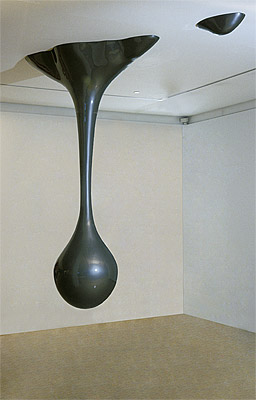NELL
Australia
1975
The perfect drip
1999
enamel on fibreglass, polyurethane foam, wood, polyvinyl chloride pipe, filler, primer
237.0 (h)
x 150.0 (w)
cm
Collection of Catherine Lezer and Kevin McIsaac, Sydney
Image courtesy of the artist and Roslyn Oxley9 Gallery
When contemplating sculpture, we probably think of carved marble figures, painted wood reliefs, monument in bronzes, or abstract constructions in steel. It’s unlikely, I suspect, that a giant, stylised drip descending from the ceiling would spring to mind. Traditional sculpture is durable, monumental and static. Nell’s The perfect drip 1999, on the other hand, encapsulates a multi-dimensional moment, a space-time continuum, and really does look as if it might fall. The aesthetic language that informs this sculpture is, paradoxically, drawn from the ultimate two-dimensional medium―film. The perfect drip is, as the artist tells us, perfect. On the surface at least. Should we be afraid?
‘Real’, ‘reality’, ‘realise’. Photography and, by extension, film, are often considered the mediums in which to portray events from life most realistically. The amorphous and space-age qualities of The perfect drip have their origins in computer-generated, action-packed sci-fi movies where we know perfectly well that the hero won’t die, but suspension of belief is part of the fun. Nell’s materials embrace another incongruity: the painted fibreglass, foam and wood constructions found on film-sets appear convincing, but when we actually encounter them the artifice is readily, almost painfully, apparent. We know Nell’s ludicrously large drip won’t fall, and because of this we admire the skills required to produce this visual joke. It’s part of the inherent contradiction of portraying fluidity with solid materials. Has anything happened yet?
‘Drips’ appear regularly in the artist’s oeuvre or, rather, often enough to be identifiable as a motif, even for one of such diversity as Nell. In a 1999 installation, The fly and the mountain, the junctions between the ceiling and the walls, as well as other architectural features within the gallery space, were the focus of her attention. But unlike Richard Serra’s experiments with lead—or Jackson Pollock’s expansive gestures on canvas, or even Lynda Benglis’s ‘frozen gestures’ in foam—this was not an instance of privileging a working process over the final product. [1] At a distance the pools of thick grey matter that oozed through window frames, down walls, and onto the floor below, threatened contagion. The approaching visitor was surprised, or amused, to discover that the ooze was actually composed of many, many plastic flies. Groooss! Elsewhere Nell has produced fibreglass noses that drip, and stylised abstract, even calligraphic, renditions of drips on canvas. As fellow artist Lionel Bawden points out, when it comes to materials Nell’s promiscuity is beyond compare.[2]
The perfect drip has the viscosity of oil, the mirror finish of a finely polished automobile. The fact that it’s dripping from the ceiling is immediately disconcerting: is this a water leak or build up of moisture? Could it be coolant from the air-conditioning? An oil leak? Something nastier still? In architectural or automotive terms, a drip cannot be perfect; more often than not a drip signals the need for expensive repairs. These disturbing but comical contradictions are the sculptural equivalent of Salvador Dali’s soft watches in his painting, The persistence of memory 1931.[3] Nell reprises ideas raised by Surrealist and Pop artists, possibly with a side-swipe at Abstract Expressionism, but her work is also a fine example of fluidity in sculptural form. Man, are we there yet? I’ve given up waiting for that drip to fall!
Lucina Ward
Curator,
International Painting and Sculpture
National Gallery of Australia, Canberra
[1] For Splashing 1968, his first lead ‘casting’, Richard Serra spilt molten lead along the junction where the floor meets the wall in Leo Castelli Gallery’s warehouse, on New York’s upper west side
[2]Lionel Bawden, Nell: all the way, Roslyn Oxley Gallery, 18 September–11 October 2008
[3] Collection of the Museum of Modern Art, New York

